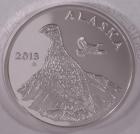2013 Ptarmigan!
2013 Ptarmigan One Ounce Silver Proof

Click images for enlargements
Ira Levinton of Anchorage, Alaska submitted the winning drawing. The medallion features two ptarmigans; one flying and one standing, with a mountain in the background. Call for availability.
Total Mintage: 1,820
Current List Price: $225.00
Ptarmigan look just like small grouse, weighing from 10 1/2 ounces to 1 1/2 pounds (0.3-0.7 kg) except that their toes are feathered, their wings are white all year, and they have pure white body plumage in winter.
In early spring, male ptarmigan become intolerant of other males and establish territories that they defend vigorously with aerial chases and a variety of gargling, croaking, and screaming noises. Sometimes the three species are found on a single mountain, and often two kinds breed close together. In such cases there is usually a clear altitudinal separation of the various kinds, with willow ptarmigan living closest to timberline, rock ptarmigan on middle slopes and low ridges, and white-tails high among rough rocky screes and boulder-strewn ridges close to glaciers or snowfields.
All ptarmigan nest on the ground soon after the snow melts. Hens usually lay six to ten eggs which are incubated for three weeks. Hatching takes place in late June and early July throughout Alaska. The male willow ptarmigan stays with the family and doesn’t hesitate to defend the brood, but male white-tails and rock ptarmigan leave the care of chicks entirely to hens. The chicks grow with amazing speed. They can get off the ground only nine to 10 days after hatching and fly well when they get their first full set of flight feathers at eight to 10 weeks of age.
Autumn is a time of restlessness. Flocks form and disperse and form again, and the birds move around into unfamiliar alpine areas. In October the wandering takes on a pattern; females tend to form their own flocks and drift lower down into brushy forest openings while cocks stay close to timberline. The extent of the fall movements varies from place to place, but migrations of 100 to 150 miles (160-240 km) one way probably are the longest undertaken by any ptarmigans in Alaska.
Ptarmigan are nomadic in winter, moving erratically from one sheltered slope or patch of food to another from November to March. The birds are quite sociable in winter and usually feed and roost in the snow close together. In April and early May, flocks of ptarmigan numbering several thousand sometimes appear in purposeful movement back to their breeding grounds. These huge flocks, perhaps created by the funneling effect of river valleys and narrow mountain passes, rapidly disintegrate when the summering areas are reached, as each cock demands his share of elbow room in the vast stretches of white and brown tundra.
The one-ounce Official Alaska State Medallion Proof should be the first medallion in any Alaska collection. It is made of .999 fine silver mined in the State of Alaska. Each medallion is rim stamped with an individual serial number and production is limited to demand through the year of issue. They come encased in an air tight holder with a velvet presentation box and information card. An information sheet about Alaska's State bird the ptarmigan comes with each medallion.

